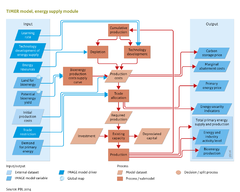Energy supply/Data uncertainties limitations: Difference between revisions
No edit summary |
(Text improvements) |
||
| Line 17: | Line 17: | ||
</td><td>[[WEC-Uranium]] ([[WEC, 2010]]) | </td><td>[[WEC-Uranium]] ([[WEC, 2010]]) | ||
</td></tr> | </td></tr> | ||
<tr><td> | <tr><td>Bio-energy potential and costs | ||
</td><td>PBL calculations ([[Van Vuuren et al., 2009]]; [[Van Vuuren et al., 2010]]) | </td><td>PBL calculations ([[Van Vuuren et al., 2009]]; [[Van Vuuren et al., 2010]]) | ||
</td></tr> | </td></tr> | ||
<tr><td>Solar and | <tr><td>Solar, wind, and hydropower potential | ||
</td><td>PBL calculations ([[Hoogwijk, 2004]]) | </td><td>PBL calculations ([[Hoogwijk, 2004]]) | ||
</td></tr> | </td></tr> | ||
| Line 31: | Line 31: | ||
One of the main uncertainties with respect to long-term supply is the size of the resource estimates at various production costs. Estimates of energy resources vary significantly, especially non-conventional resource estimates for oil and natural gas. Equally important uncertainties are the nature and rate of technological advances, and the design and implementation of energy policies in different regions. | One of the main uncertainties with respect to long-term supply is the size of the resource estimates at various production costs. Estimates of energy resources vary significantly, especially non-conventional resource estimates for oil and natural gas. Equally important uncertainties are the nature and rate of technological advances, and the design and implementation of energy policies in different regions. | ||
Various PBL publications have analysed the sensitivity of the model to supply uncertainties. The Monte Carlo uncertainty analysis of various scenarios ([[Van Vuuren et al., 2008]]) identified model parameters as important determinants of the future supply such as oil and natural gas resources and renewable energy learning rates. Some of these factors were only important for a subset of scenario output. For instance, size of oil resources was found to directly influence future oil production, but had limited impact on future CO<sub>2</sub> emissions. The main reason is that oil production in the medium-term is constrained by competition from other fossil fuels and | Various PBL publications have analysed the sensitivity of the model to supply uncertainties. The Monte Carlo uncertainty analysis of various scenarios ([[Van Vuuren et al., 2008]]) identified model parameters as important determinants of the future supply such as oil and natural gas resources and renewable energy learning rates. Some of these factors were only important for a subset of scenario output. For instance, size of oil resources was found to directly influence future oil production, but had limited impact on future CO<sub>2</sub> emissions. The main reason is that oil production in the medium-term is constrained by competition from other fossil fuels and bio-energy. The results were also shown to be scenario dependent. Fossil fuel related uncertainties were more important in a scenario that resulted in a high rather than low fossil-fuel demand. | ||
===Limitations=== | ===Limitations=== | ||
Revision as of 16:39, 25 April 2019
Parts of Energy supply/Data uncertainties limitations
| Component is implemented in: |
|
| Related IMAGE components |
| Projects/Applications |
| Key publications |
| References |
Data, uncertainty and limitations
Data
Main data for the supply side of TIMER are the size of the resources available at different production costs (the table below).
| Data input | Sources |
|---|---|
| Fossil-fuel resources and costs | [!CHANGE] [[IEA, 2017]], [[USGS, 2012]]; [[BGR, 2016]]; EDGAR database; [[Abundant Gas Project]]. Costs mainly based on Rogner et al. [[(2018, in prep.)]] |
| Nuclear fuel data (uranium and thorium) | WEC-Uranium (WEC, 2010) |
| Bio-energy potential and costs | PBL calculations (Van Vuuren et al., 2009; Van Vuuren et al., 2010) |
| Solar, wind, and hydropower potential | PBL calculations (Hoogwijk, 2004) |
| CCS potential | Based on (Hendriks et al., 2004b; IPCC, 2005) |
Uncertainties
One of the main uncertainties with respect to long-term supply is the size of the resource estimates at various production costs. Estimates of energy resources vary significantly, especially non-conventional resource estimates for oil and natural gas. Equally important uncertainties are the nature and rate of technological advances, and the design and implementation of energy policies in different regions.
Various PBL publications have analysed the sensitivity of the model to supply uncertainties. The Monte Carlo uncertainty analysis of various scenarios (Van Vuuren et al., 2008) identified model parameters as important determinants of the future supply such as oil and natural gas resources and renewable energy learning rates. Some of these factors were only important for a subset of scenario output. For instance, size of oil resources was found to directly influence future oil production, but had limited impact on future CO2 emissions. The main reason is that oil production in the medium-term is constrained by competition from other fossil fuels and bio-energy. The results were also shown to be scenario dependent. Fossil fuel related uncertainties were more important in a scenario that resulted in a high rather than low fossil-fuel demand.
Limitations
The general limitations of TIMER also apply to energy supply modules with a few specific limitations. As a global model, TIMER specifies resource availability in 26 global regions. However, to some degree this does not take into account the underlying geographical dimensions of individual countries and specific areas. For fossil fuels, this issue leads to heterogeneity within a region (e.g., due to different tax systems), but is more important for renewable energy. A key factor can be transport from one area to another, and calculations require the use of other models.
Another main limitation concerns the focus on production costs in describing energy markets. Although long-term developments may be expected to be driven by long-term supply costs over the last few decades, issues related to capacity constraints and market formation over longer time periods have lead to fossil fuels prices that differ from production costs.
